On 21 May 2017, The Guardian newspaper published an article entitled ‘Did Dutch Hordes kill off the Early Britons who started Stonehenge? It highlighted a recently-completed, Europe-wide gene study showing that around 2,500 BC–when the main sections of Stonehenge were under construction–a race of people known as the Beaker folk arrived in Britain. Their genetic profiles were similar to those of individuals living in the Netherlands at the time. In just a short period, all genetic traces of early Stone Age Britons were replaced by those from the continental newcomers, although work on Stonehenge continued.
‘It is very striking,’ comments Garrett Hellenthal, a statistical geneticist at University College London. ‘There seems to have been a complete replacement of the original folk of Britain with these newcomers. Normally you get some older DNA surviving with the wave of immigrants, even a fairly large wave. But you don’t see that in this case. Frankly it looks more like an invasion.’
While puzzled geneticists scratch their heads, a possible solution to the mystery has appeared, and from an unexpected source. Several chapters in the Kolbrin’s Celtic Books, including one entitled ‘The Dawndays’, contain what purports to be a record of British origins ̶ and, surprisingly enough, the Kolbrin account matches these latest DNA findings. (For more on The Kolbrin, see my earlier article, Guide to the Kolbrin.)
The Celtic books of the Kolbrin (which has no recent provenance) are thought to have been copied in the second part of the 7th century AD from older manuscripts, and were published in modern English in 1994. These particular chapters in the Book of Origins or Ferilbook were copied by Airden, son of Sead Magfergas, in ‘the common tongue’ [Brythonic] and later translated by John Luid Ledylith (now courtesy of The Culdian Trust).
This Celtic text retains much of its original Anglo-Saxon style. Readers may be incredulous when they read about the dwarfmen (only a fraction is quoted here, and the whole account makes gloriously entertaining reading), but they should bear in mind that the scribe was probably a monk who delighted in drawing together dark pagan folk memories, removed from his own way of life.
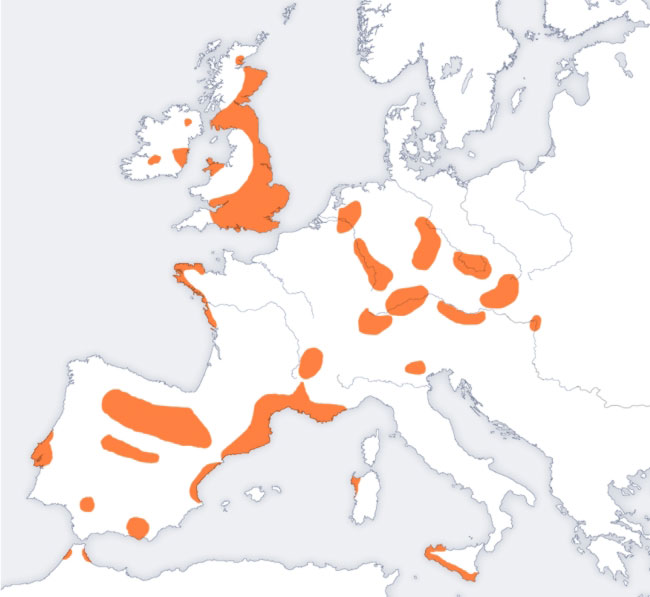
Map of Bellbeaker Finds. Data taken from RJ Harrison, ‘The Beaker Folk: Copper Age Archaeology in Western Europe. Ancient Peoples and Places,’ 97, London 1980. (CC-0)
Oben/Dwarfmen and Frolga
The ‘Dawndays’ chapter begins:
The first folk holding this land [Britain] were the Kamledis, called Wictarin [Picts?] in the old tongue [Brythonic], but these were dwellers in the North, while southward were the dark, short-legged dwarfmen known as Oben [Germanic, meaning ‘higher ground’]… None knows who led the dwarf men here, though men do say the land spawned them… They were hag-ridden, forest-fearing river-dwellers who painted their faces and legs, users of easily poisoned weapons. Theirs were the grim gods of death and darkness, and at the festival times the dwarfmen sat in sombre caves eating children as part of their evil feasting… In the generations of the dwarfmen, broad Britain was a many-marshed land, where dismal ferns and tangled forests hindered passage from place to place. The Oben were not numerous and their children few, but they were hardy and long-lived… Far to the South were the swarthy swarm of the Frolga [who were “herd-keeping”], though these were not true dwarfmen but the outcome of intermingled blood.
The Kolbrin makes it clear here that the Oben were Britain’s oldest inhabitants.
The Coming of the Nudlanders
Now follows one of the earliest written accounts of immigration into Britain:
Into the land held by the short dark Oben, came tall wiry Tothsolars, who were sunfolk. They came through Airana [Proto-Iranian, arya ̶– meaning ‘Aryan/of the Iranians’] and the country of the Nudlanders [Neder/Nieder/Netherlanders meaning ‘lowlanders’], who wore gallitraps [ornamental clothing], and it was in those days men began to breed swine, the first beast bred to be eaten, for only the dwarfmen eat cats and dogs. The land was then called Muredin, meaning the place of rest… Then into the easterly lowlands came sea-borne Baradon with his plowmen… These are tales of times before men were men, when the big-bellied murkymother ruled the world-covering Netherfolk [dwarfmen], sharing the land with giant Endlings…
Into the dark, wild, wooded land came blood-haired Lodmor, son of Kel, wave-borne, encased within the ship bellies of oak and beech… Up the flowing waters… came the fair-skinned wanderers. Not with fight-straining eyes, but with hands empty of weapons and guileless hearts, seeking only to live out on the grass-thatched plains.
In other words, a wave of tall, wiry, fair-haired, blue-eyed Nudland people moved into Britain, only to find the land already inhabited by a sparse population of small, dark dwarfmen and a few remnants of a race of giants. This, the Kolbrin points out, was not a violent invasion, but an influx of newcomers trying to make a new life for themselves.
Today’s Dutch population includes some of the tallest human beings in the world, which gives a rough idea of how tall these newcomers might once have appeared and why the existing inhabitants might been thought of as dwarves. But it’s worth noting that the Oxford English Dictionary defines ‘dwarf’ (Old English duerg/dweorg/dweorgh) as ‘a human being much below the ordinary stature or size’. The term was not used to mean ‘of stunted growth’ until after the 17th century. Nowadays, if gigantism or short stature is detected in a person’s DNA, it is more likely to be categorised as a medical condition than included in their racial inheritance. It’s also worth noting that the Kolbrin clearly differentiates between ‘tall’ and ‘giants’.
British Giants
Several historic texts refer to giants living in ancient Britain. Geoffrey of Monmouth writes in his 11th-century De gestis Britonum or Historia regum Britanniae that when Brutus of Troy landed at Totnes, he found the land inhabited by men ‘of no normal stature’. Friedrich Brie’s translation of the 13th-century Anglo-Norman Brut Chronicle tells of King Diocletian’s 33 Syrian daughters (the eldest named Albyne) who murdered their husbands, were set adrift at sea and landed on an island which they named Albion, where they mated with ‘devils’ and gave birth to giants. The Kolbrin calls them ‘giant Endlings’ (the last of their race?) and adds, ‘The same giants are builders of great temples and they are six cubits [nine feet] tall.’ Could these ‘builders of great temples’ have built Stonehenge?
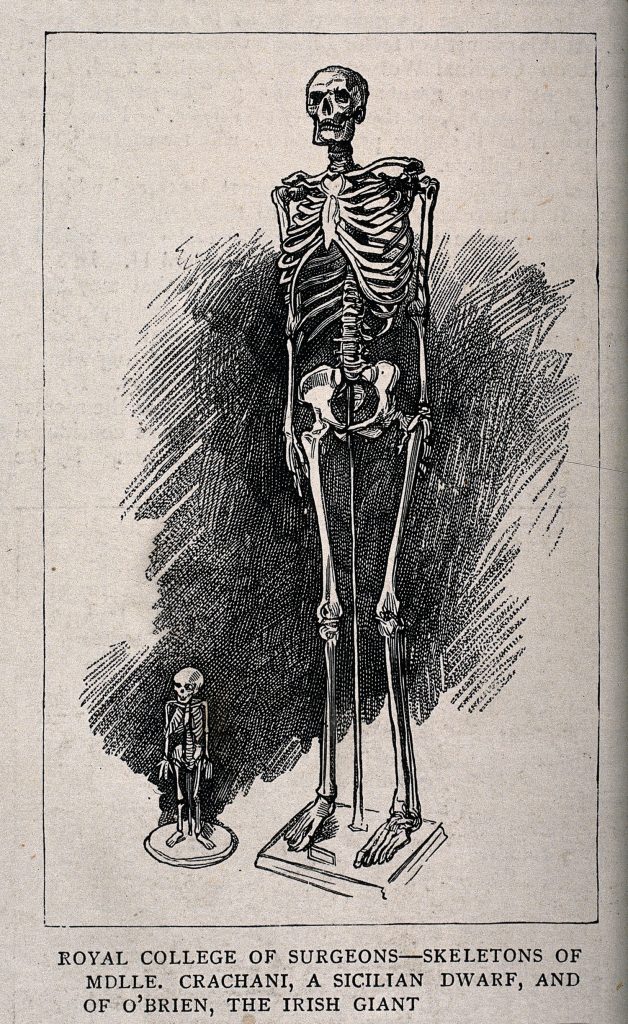
Skeletons of a male giant and a female dwarf, displayed at the Royal College of Surgeons. Wellcome Library no. 38394i © Wellcome Library, London (CC-BY-4.0)
Nine feet seems to have been the average height of ancient British giants. A hunt through the British Newspaper Archives has revealed that around 50 sets of bones and skeletons between seven and ten feet in length have been unearthed in Britain over the past three centuries. The Annual Register of Cornwall for 1761 records that in the tin mine at Tregoney-on-Fal, a stone coffin measuring 11 feet 3 inches x 3 ft. 9 inches was found, containing a skeleton 10 feet long. The remains crumbled to dust when it was exposed to the air. And several giants recorded down the centuries attest to gigantism carried in British DNA.
When Tothsolar met Oben
The Kolbrin relates the utter disgust felt by the Nudland newcomers when first they set eyes on ‘the feast of offal, the fire-smoke dancing, the open coupling’ of the dwarfmen, who covered themselves with pigfat, soot, blood and clay. These Netherfolk ‘desired only to remain undisturbed’, so the Nudlanders ignored what they saw and tried to settle. But when the Oben/dwarfmen stole one of the Nudland children, a battle ensued ̶ a strange conflict between, on the one side, face-to-face axe and sword, and on the other, terrorist-style poison darts fired from tiny flitting forms in the forest. Finally, a dwarfman elder returned the stolen child unharmed ̶ together with the heart of his abductor. Dwarf emissaries came to a solemn peacemaking. Some Nudlanders thought they should enslave this dark brood of dwarfmen and ‘pen them as cattle‘. But ‘to enslave was not the nature of the Upstanding Ones. Blood had been ransomed with blood and no score remained unsettled. No woman of the dwarf folk was beridden…
‘Thus,’ says the Kolbrin,
was the way opened for the fairfolk to enter the land… There they raised noble sons, white-browed, blue-eyed, slim-womaned and dutifully wifed… In from the moors to carry timber and stone came … blue-skinned [tattooed] people, dark-cloaked, mossy-haired men akin to the Oben… It was agreed the dwarf folk should live under the shield of Lodmor and they would labour in return. Then Killen gave them sticks for hoeing and digging, long stones for planting. Leaks, beans, flax, barley and wheat were unstintingly given, along with woven haircloth. In wooded glades cleared by tree-encircling fires, the sowing commenced, the bough bowers were built, the swine enclosed.
The dwarf-chief’s virgin daughter was brought as a bride-offering to the chief of the Nudlanders and in return, the dwarf-chief requested ‘a tall, corn-haired maiden, full-bosomed, fair-skinned, sun-faced, to enliven gloomy lives’. When he heard this, the Nudland chief declared: ‘She may bide as a bride of yours, but surely it is known no milk-skinned maid would sever herself from our race, for return with a dark brood is forbidden. … No dark brood do we accept, our men with your maids go, but what come of it is not one of us, no acceptable issue of ours. We father no dark brood, nor twilight offspring.’ In other words, the Nudlanders made it clear that they would not accept any mixed offspring that might result from sexual dalliance between the two groups. After this declaration, ‘no milk-skinned maid came freely forth’ ̶ leaving the Oben chief abashed and unwed.
Strange as it sounds, there may well have been a strong genetic reason for the Nudlanders wanting to preserve their bloodline. The Kolbrin’s Book of Creation tells of an early human species more advanced, more disciplined and spiritual than other human beings called ‘The Children of God’. The Children of God were descended from forefathers who had crossed ‘the great dark void’ (outer space?) and one of them was selected and brought to live in the Gardenplace (the Garden of Eden) in the Indus Valley (see my earlier article Was this Eden? Locating the Kolbrin’s Gardenplace); the woman who became a mate for the chosen man ‘followed the ways of the cradleland, not the ways of Earth’. This chosen couple regularly drank special essences, ‘when the Heavens were in a proper position’ to keep sickness and disease away, as did their direct descendants. But when the man’s daughter had sex with a Yosling [a race who were ‘not true men but … kinsfolk to the beasts of the forest’ living outside the Gardenplace], she grew ill, the Yosling grew ill ̶-everybody grew ill ̶ and some died.
The Kolbrin states that shorter human lives, the many diseases humans are prone to, women’s monthly periods, painful childbirth ̶ all stem from the time of the ‘forbidden’ interbreeding. After this terrible genetic misadventure, climatic change forced the ‘Children of God’ to leave the Indus Valley, and they made their way south of the Caspian Sea to Airana (Iran) and Krowkasis (the Caucasus). If the people who moved west through Nudland/the Netherlands to Britain were descendants of the ‘Children of God’ (and they probably were, because every time the Kolbrin speaks of a group preserving its bloodline, it seems to be descended from the Children of God), they would have tried to keep their bloodline free from further genetic disaster. In today’s politically correct times, the Nudlanders’ attitude to the Oben might sound like blatant racism. But their refusal to interbreed was not about racism; it was about species–ism
The name ‘Tothsolars’/sunfolk might offer a possible clue to their identity. In the OED a now-obsolete use of the word ‘toth’ is recorded; although its meaning is uncertain, the contexts in which it has been found imply that it refers to some kind of wrong-doing.
There had not been many Oben to begin with. Now, with this strict prohibition on interbreeding, and as the Nudland incomers moved further into the land,
Less and less [were] the dark brood numbers, further back into the forest and cave went the dusky-skinned ones. Oft in the night darkness fair maids were snatched by brown-cowled dwarfmen, to breed twilight broodlings in secret places. Woeful were the enforced couplings and woeful the issue. Not for milk-skinned maids the free sinful coupling of the foredoomed dawn-race!
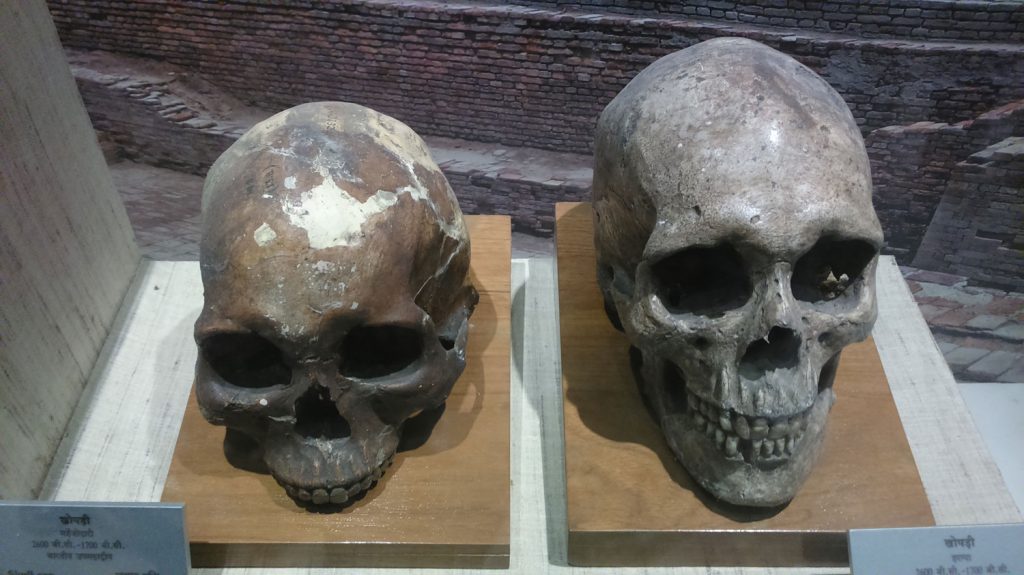
Skull of Indus Valley inhabitants, Indian Museum © Royroydeb (CC-BY-4.0)
The Vanishing
As a result:
In five generations the Nethermen [Oben/dwarfmen] were gone [my emboldening], only in the dark depths of cave and forest could they be found. No longer were the milk-skinned maidens molested at night. The night offerings were put out; the dwarf-men came and supped; honey, bread, milk and sow-flesh were taken in gratitude. The race of Nethermen passed into the shadows of time, only twilight offspring roaming the land, tawny-faced, blue-legged, weirdly-painted, brown-cowled, rope-belted, builders with stone.
No longer dwellers in dismal caves, or hunters in dark-mired swamps, the Alfing [mixed-race offspring of couplings between Oben/dwarfmen and kidnapped Nudlander women] built slime-covered bough houses and raised high, upward pointing stones. Still soot-besmeared, pigfat-ointmented like the dark-side of their forebears, they were also feathered and quill-ornamented. Being twilight-fathered they faced no man courageously, coming to the attack like ground-slithering snakes, striking venomously from secret places, still forest-skulkers. None could recite his lineage, for no man knew his father. These were mother-lap-reared half-folk, speaking with the tongues of their fathers, their words like crackling, spluttering green twigs burning in the fire. Brown and green-clothed, be-bangled, stone-hauling Idunings toiling for their black-bearded masters for unknown ends.
How long was five generations? The International Society of Genetic Gealogy refers to a contemporary hunter-gatherer people of Botswana/Namibia whose lifestyle is probably close to that of our pre-agricultural ancestors. The average age of mothers at birth of their first child was 20 and at the last birth 31, giving a mean of 25.5 years per female generation. Using this as a rough measure, the Stone Age Britons disappeared just 100-125 years after the Nudlanders appeared. Britain was now home to a different race, along with a smattering of mixed-race descendants of the Oben/dwarfmen known as ‘Alfing’, and a few giants.
A Legacy of Legends
The Oxford English Dictionary lists ‘aelf’ as the earliest spelling of ‘elf’ and defines it as ‘a class of supernatural beings, in early Teutonic belief supposed to possess formidable magical powers… They were believed to be of dwarfish form, to produce diseases of various kinds, to act as incubi and succubi, to cause nightmares, and to steal children, substituting changelings in their place.’ What emerges loud and clear from the Kolbrin record is that European folk memories of the Oben dwarfmen, their mixed offspring the Alfing/Aelfing (from which we get the word ‘Elfin’) and the last of the giants left a legacy of colourful legends featuring fairies, elves, goblins, dwarves and ogres. Incidentally, the Kolbrin also contains, both in its Egyptian and Celtic books, an extremely ancient account of Gwineva the Cuckoochild/Gwinvera ̶ the first mixed-species, red-haired person on record ̶ who was protected by prehistoric dwarfmen and is the prototype for the Snow White folk motif handed down over the centuries.
The Kolbrin describes the Alfing/Elfin as ‘builders with stone’, ‘stone-hauling’, and says that they ‘raised high, upward pointing stones’. Could it have been the Alfing who built the stone circles scattered throughout Britain and parts of Europe? And did giants labour alongside them?
Other Immigrant Groups
The Nudlanders were not the only ancient immigrants to Britain, according to the Book of Origins. The ‘black-bearded masters’ for whom the Alfing worked were another wave of incomers from ‘Ilopinos’ ̶ Troy. On their way north in ‘many ships’ they chanced upon a convoy of ships from Tyre carrying the Sons of Fire, metalworkers with their families, and together they travelled to Britain.
The Sons of Fire were craftsmen descended from Egyptians who had fled their land following religious persecution.
The Kolbrin mentions a second group of metalworkers called Merkings, ‘who remain among the Kwicta [Picts?]’ and who told stories of their flight from the West,
where their forebears lived in painted abodes cut out of rocks. It is now the land of Manan and closed, for it burst asunder at the bowels, streaming out through Linleon during a great night of darkness.
The Trojans
The Trojans were led by Albanik and their Commander of Captains ̶ an unnamed man who was said to have accidentally slain his own father while out hunting and been forced to flee his own land. Anyone who has read Nennius’ 11th-century Historia Britonum or Geoffrey of Monmouth’s 12th-century De gestis Britonum or Historia regum Britanniae will recognise at once this description as belonging to no other than Brutus of Troy, descendant of the Trojan hero Aeneas, founder of London and the first king of Britain.
The Kolbrin calls south-west Britain ‘the Land of Dada’. In Holinshed’s 1580s Chronicles the town now known as Totnes is called Dodonesse; Dada ̶-Dodonesse ̶ Totnes. Totnes is said to be where Brutus first set foot on British soil, and an ancient Brutus Stone set in the town’s main thoroughfare, Fore Street, still marks the event. Another ancient stone can be seen at 111 Cannon Street, London, commemorating Brutus as the capital’s founder. He called the city New Troy, a name which later changed to London.
Korin of Sparta
Alongside the Trojans were men from ‘Sparsia’ (Sparta) led by Korin, ‘the cunning one’. Korin’s ship was among those that went on to the Harbour of Giants in Belharia (Plymouth area? St Michael’s Bay in Cornwall?). There, Korin ‘hunted the giants out of their caves and slew them all, save for one giantess’ who was handed over to the local people for the Feast of Fires ‘when their god Mago appeared. Inside the god were the spirits of men whom the god had eaten, and their voices could be heard calling for deliverance from darkness.’ This is clearly a description of the huge wicker figure used by Celtic pagans for human sacrifice, described by Julius Caesar in his Commentarii de Bello Gallico and by the historian Poseidonius, and featured in 1973 and 2006 films ‘The Wicker Man’. Modern historians consider such descriptions to be grossly exaggerated: the Kolbrin says otherwise. The Book of Origins account also mentions that the Spartans drew back when they saw the locals drinking blood.
At the end of the festival, Korin wrestled the giantess over the cliff to her death (an event also recorded in the Brut Chronicle). Until the early 17th century, large outline images of the giants Gog and Magog (sometimes identified as Goemagot and Corineus) were cut into turf covering the limestone clifftop at Plymouth Hoe, south Devon. (An audit book of 1514 contains the note, ‘John Lucas, sergeant, had 8d. for cutting Gogmagog.’) The two chalk figures commemorated Lam Goemagot – ‘the Giant’s Leap’ ̶– where the giant was cast into the sea; the place is called Giant’s Leap to this day. Later, Korin took two boats and sailed off in search of ‘Painted Men’ who had plundered their supplies, but he never returned. Korin is better known as the legendary Corin/Corineus after whom the county of Cornwall takes its name.
The Wildland Cultivators
The Kolbrin record includes an incoming race of horsefighters known as the Wildland Cultivators. They came from Krowkasis (said by Pliny the Elder in his Naturalis Historia to be a Scythian name for the Caucasus).
They landed at the place beforetimes called Haltraith, in the land of the Horsefolk, now held by Engling [English/Anglo-Saxons]. They built the wood-walled town called Hovenlee in the new tongue. [Was this Hove? An excavated burial mound there has been found to contain a translucent red amber cup made in the Baltic].
They took their land from the herd-keeping Frolga and ranged wide from shore to shore, renaming the water-encircled land, the Honeyladen Isle, for never before had they seen honey in such quantities since leaving their own land… There were bears, wolves, wild cattle, boars, oruks, deer, elk, lion-cats, man-eating water lizards and beast-eaters that dwelt in lakes a-plenty… Behind the Wildland Cultivators came the Uksening, but being boatless few came to this green land, most turning southward to Amorika [Brittany peninsula]. Those who came were workers in wood and metal.
The Sons of May
These are called ‘men of the Firstfaith’. They were:
adopted sons of Britain, Pritan and the axe-wielding Baruts, and it was he [Pritan] who named this land the Great White Goddess of the Cowfeeding Pastures. The Baruts hold one day in seven holy to the Creating God whom they worship in a transparent temple where the sun falls upon the heads of the worshippers. .. The Sons of May were … ever in the forefront of battles, though they were mare-riders… They had holy trees, and like our trees of power these had to be beside a well or drinking pool.
The term ‘transparent temple’ occurs elsewhere in the Kolbrin. The Book of Manuscripts refers to an ancient group called the ‘People of the Light’ who came to Egypt from ‘Ramakui of the seven cities, Land of Copper’, bringing with them,
out of their transparent temples, the light that shines, when darkness falls, without being lit… They came from the place, where now the sun goes down, in the days when the Western wilderness was green and sand had not replaced the waters… wise they were and learned.
Hewe the Strongarm
Another immigrant group mentioned by the Kolbrin is Hewe and his followers. He is probably one and the same as ‘Baradon with his plowmen’ who came into the easterly lowlands of Britain. Hewe the Strongarm was known to the Welsh as Hu Gadarn (‘Hu the Mighty’). A Welsh adaptation of the 12th-century French romance Le Pèlerinage de Charlemagne associates Hu Gadarn with ploughing; he is referred to in the poem ‘Y Llafurwr’ (‘The Tiller of the Ground/Ploughman’) by the 14th-century poet Iolo Goch; and two 15th-century poets, Rhys Brydydd and Llywelyn ab y Moel, describe him as semi-divine. A tradition exists in Welsh mythology that Hu Gadarn’s people came via the Middle East from ‘Defrobani’ (a Welsh version of the Greek Taprobane/Taprobana, meaning ‘Summerland’, first mentioned in western records by Ptolemy and thought to have been either Sri Lanka/Ceylon or Sumatra).
Hewe’s is described as a golden age. The Kolbrin doesn’t tell us where Hewe came from, but it sounds as if his coming was part of a wave of immigration which began with the Nudland Tothsolars, and which brought agriculture across Europe to Britain. In 2015, a species of domesticated wheat known as einkorn was identified in sediment recovered from an underwater Mesolithic site in the Solent, just off the coast of the Isle of Wight. This suggests that the Neolithic agricultural revolution may have reached Britain 2,000 years earlier than previously thought – but alas, there are no dates in the Book of Origins.
The Kolbrin says that Hewe was,
Chief of the Well-born Ones… bright-bearded, blue-eyed, but not over-tall. He was the bronze-bound ruler of warriorful Hefa, a place lying out in the shallow seas eastward of Britain, with a many-moated white castle and high coloured walls… Hewe taught men to plough and till the soil. He ‘crossed to the Summerland where he set up a great school of learning … The fighting folk who came with Hewe were outstanding….
He [Hewe] first … made the soil to be uplifted, overturning it upon the winter-held grain. He first brought the long ox-drawn field-rakes and carried fertility to the pasturelands. Winters were no longer times of hunger, for now all ate without stint from hide-lined cellars filled with fire-dried corn… High-raftered the roofs over the eating hall, broad-beamed the guest hall, high-raised the host hall…
These were the times when days received their names and weeks their numbering. The coming of the moon was made known and daylight was divided into four parts. The three parts of night were named and the two times of eating. Men knew the four divisions of the year and their names were known…Before Hewe, folk saw at night only by … firelight… but he gave them fat-lamps.
Peaceful the lush, green land, peaceful all that dwelt between surging seas. From Partain, the fine bright bronzework, the big-bellied pots [my emboldening]. From Longaset, the hides and horn-work, the work of strange smiths. From the Liky, earth-hidden things borne away in far-faring boats. From Setnaspor, the hard sharp stone tools, the ripe corn-cutting knives. Yearly, from the Erim at Haroganos came the tribute of murkymaids [mixed descendants of the Oben], mothers of the studbrood, workers with hillside herds and forest feeders, gatherers of wood and fruits.
Here at last is a mention of the bell-shaped, fat-bottomed Beaker pots!
Towards the end of these chapters on immigration, the word ‘Keltic’ appears for the first time:
In Britain, the two folk beliefs of Keltica met and merged, and though beforetimes they had been mutually hostile, later they could no more be separated than milk and water shaken up together in a jug. So throughout the land there were now two peoples, those who came before the Kelts and were children of this land [descendants of the Oben], and the people of Keltica who travelled much on water and lived near rivers and lakes [the various incomers]. The small-statured dark folk favoured the deep forest and high hills. Different from both were the Painted People who lived largely on herbs.
The language of the pre-people was rarely spoken, being the tongue of slaves and wayfarers, men who wandered. To the West, the people spoke the tongue of foreigners [Phoenician?]; to the East, they spoke Brythonic and to the South, Lemany [layman’s language?]. In the South, below the white lands of Albany, there were marshes.’ [In his 2009 Open University TV series ‘Landscape Mysteries: Secrets of the Flood’,’ the zoologist Professor Aubrey Manning investigated the Solent, the sea dividing the Isle of Wight from mainland Britain. Divers/archaeologists have found that sea levels there have risen considerably over the past 8,000 years, and seabed-core samples show that for much of that time, the Solent area and all along the southern coast was not sea at all, but marshland.]
This tells us that, despite early prohibitions on interbreeding, the indigenous people of Britain and the incomers eventually mingled, mixed and mated.
DNA Meets Legend
When we set archaeological and DNA finds alongside the Kolbrin’s dawndays, the result is a remarkable record.
And ̶ whisper it who dares ̶ a smattering of dwarfman DNA must surely have passed into the British gene pool, judging by the British penchant for relapsing into sex, drugs and mayhem at festivals and on holiday, and the fact that many British have disproportionately short legs beneath their long torsos; while Nudland DNA is evident in a swathe of tall, long-legged, blue-eyed Brits.
The British emerge as one of the world’s most mongrel races, with a rich, ancient DNA woven from dwarves and Nudlanders, Trojans, Spartans, Tyrians, Egyptians, Ceylonese and Caucasians -̶ not to mention Assyrians and a smattering of giants. All this, even before the Romans, Anglo-Saxons and Vikings arrived…
By Yvonne Whiteman: [email protected]
With thanks to Manuel Cufre







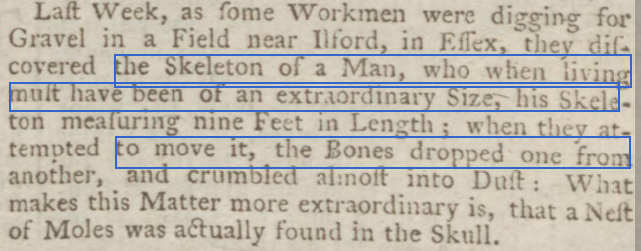
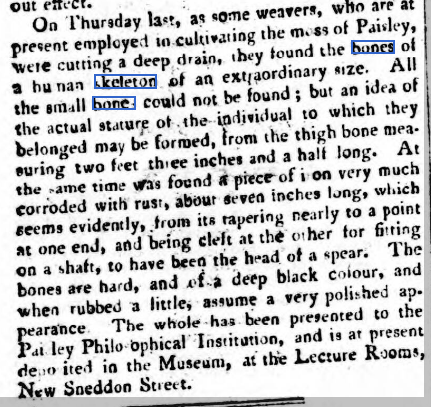
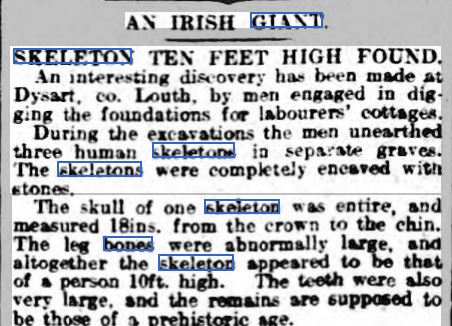
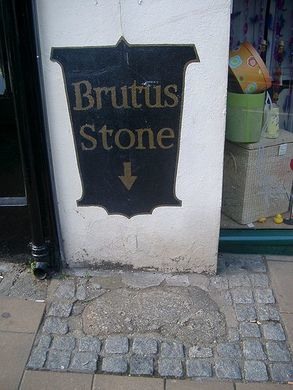
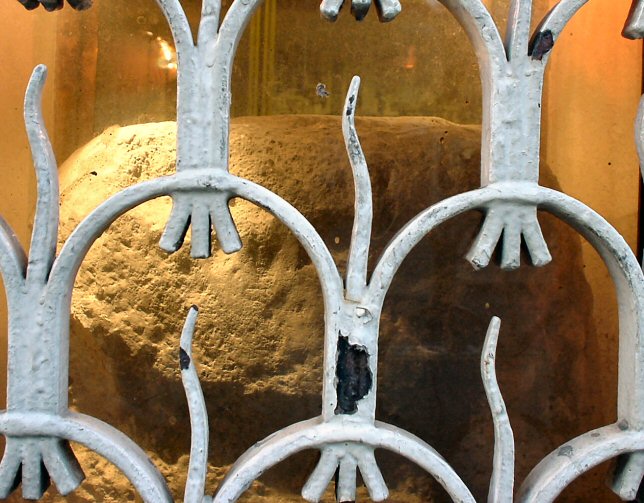
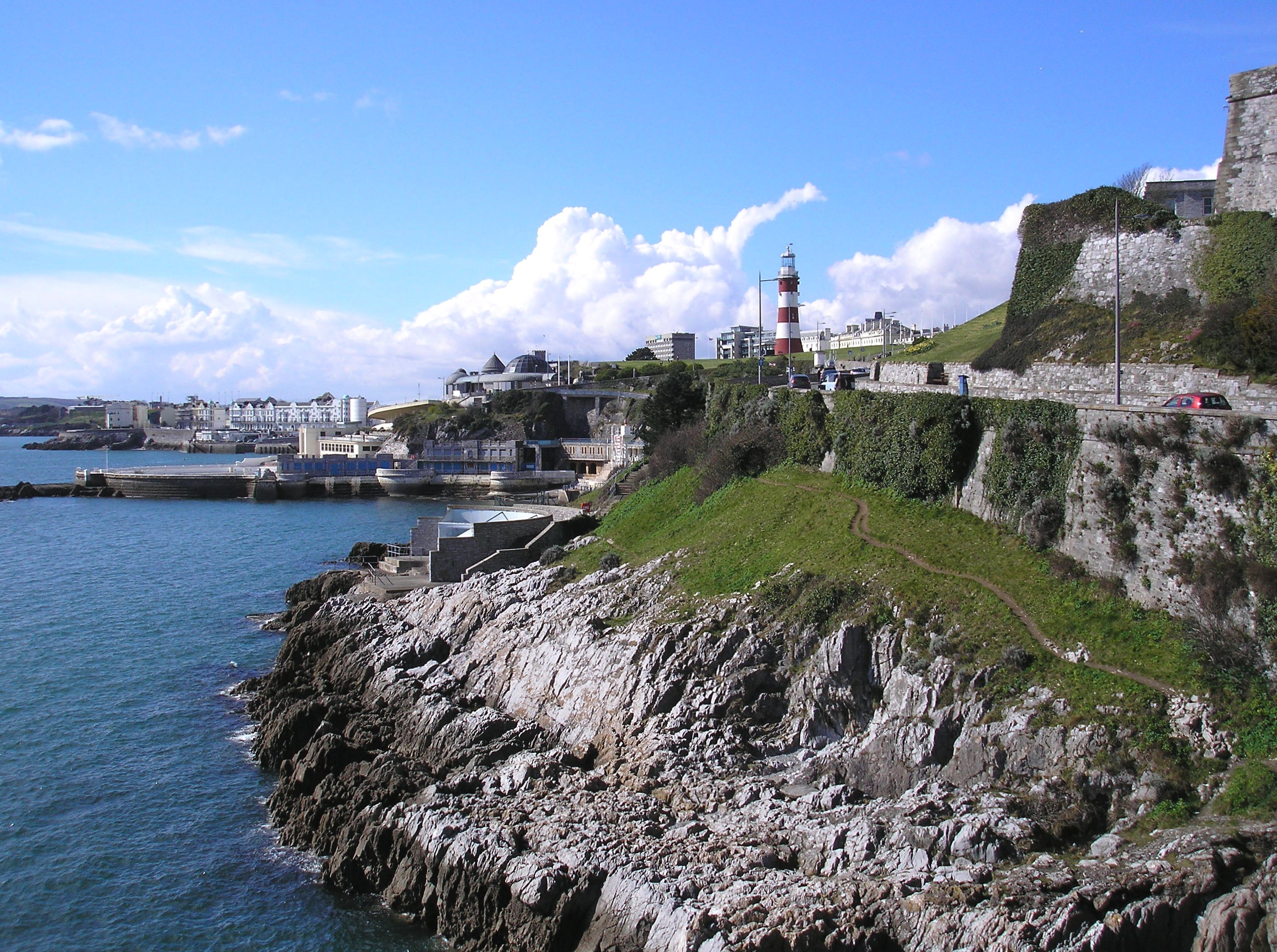
To affirm what is mentioned on this page regarding extremely tall people, below is my history of my hometown and the discovery of giant skeletal remains as eye-witnessed by my grandmother.
My hometown in the mountains of Lebanon page, please see:
https://phoenicia.org/souk-el-gharb-bmakine.html
Under the subtitle, Bmakine, Syriac for the low Place, in the second paragraph, I write:
Terra Cotta Sarcophagi and Giant People
My grandmother told me that when they were double digging her parent’s estate in the late 1800’s, many terracotta sarcophagi were discovered and some contained remains of very tall people or people who suffered from abnormal growth. Femur bones of some of the skeletons almost reached the shoulder level from the ground of workers. To my knowledge, no archaeologist had a chance to examine the digs but the remains were re-interred…etc.
Since writing this article, I have learnt that the London Stone has been moved to permanent display at the Museum of London, 150 London Wall.
Thanks, Yvonne. Interesting as ever.
Regarding the Oben/Dwarfmen, look on Wikipedia at Ebu for a name from deep antiquity given to the cave-dwelling, child-eating dwarves of Flores, their presence now attested by skeletal remains. In my translation, The Story of Sukurru, I came across the origin of the name. It is, as might be expected, a joke. E-BU, lofty and wide! The early Sumerian language has the particularity of word-play through inversion. There is no letter ‘o’ in the phonetic forms so I would suggest that UB-E is the inversion, UB being angular (or something of that sort). Then again, EN does have the meanings of noble and end, perhaps a further play on words or a contraction of UB-E-EN. Anyway, a strange coincidence, don’t you think?
Madeleine
Excellent article. I am also deeply interested in the past. I just feel that something is wrong. We have a very wrong view of the past.
The Welsh have the R1B type shared with the Basque and others. What group does that fall into?